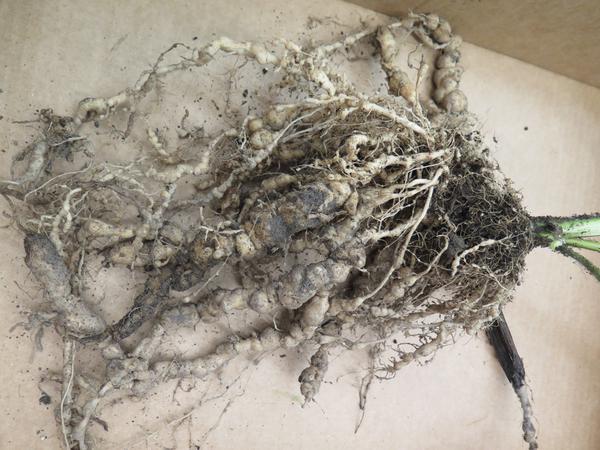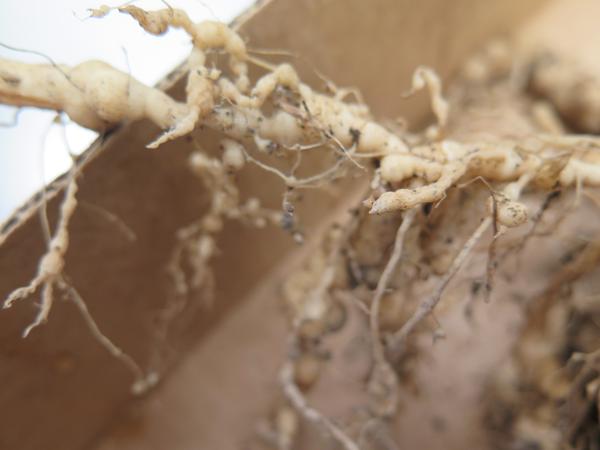How To Clear Grass For A Vegetable Garden
Introduction
Skip to Introduction
Nematodes–especially root-knot nematodes–cause major losses in vegetable crops in commercial farms, greenhouses, and home gardens in North Carolina. Root-knot nematodes are microscopic roundworms that can pierce the roots of certain plant species and lay their eggs inside the roots. This gives the roots a "knotty" appearance (Figure 1 and Figure 2) and results in a wilted or stunted appearance of the whole plant. Meloidogyne incognito, the southern root-knot nematode, is most common in North Carolina, but other species have been found recently. These pests occur in about two-thirds of the fields used for crops in the state.
Although many spring-planted vegetables such as beets, carrot, English pea, lettuce, potato, radish, and others are susceptible to root-knot nematode, they can be grown in infested soil and suffer only minor damage because nematodes are inactive at low soil temperatures (60°F). However, these same vegetables can suffer extensive damage when planted in the late spring, summer, or fall when soil temperatures are more suitable for nematode activity (70–85°F). Other common garden vegetables grown during mid- to late summer, such as tomato, pepper, cucumber, squash, eggplant, and okra also are highly susceptible to root-knot nematode.
Plants growing in nematode-infested soils usually are unthrifty, stunted, yellowish, and have galled and decayed roots. Plants with infected roots are more susceptible to other diseases caused by fungi and bacteria and tend to stop producing early. Root-knot nematode problems can be detected by examining the roots of vegetables for the conspicuous root galls (swellings) as soon as harvest is completed or through a soil assay. Crop losses due to these nematodes can be greatly reduced by using available control practices. However, control steps must be taken before planting or seeding. Once the nematodes are inside the roots, effective treatments are not available. This publication describes ways to minimize nematode problems by employing one to several control measures. The most reliable control of root-knot nematodes can be achieved by integrating two or more of the tactics described herein. Combining an effective rotational scheme, resistant varieties, and selected cultural practices gives excellent control with little added cost.

Figure 1. "Knotted" roots on a tomato plant caused by root-knot nematode.

Figure 2. Close-up of "knotted" roots on a tomato plant infected with root-knot nematode.
Rotation
Skip to Rotation
Crop rotation is one of the oldest and most economical methods of controlling nematodes. Rotation is simply the practice of not growing a susceptible host in the same site for more than one year. Typically, planting a highly susceptible crop a few feet from where it was grown the previous year will avoid damage by nematodes. Also, if space is available, the entire garden site may be moved to a new location after one or two years. When the garden site is moved, it is helpful to select a site that has been in grass for several years. Non-host plants that are especially suitable for rotation with vegetables include fescue, small grains, and marigolds.
Home gardeners should seriously consider succession planting (multiple cropping) in the rotational scheme. For example, if a short-season vegetable that is susceptible to root-knot is grown in one area of the garden, a fall crop (such as a resistant variety of tomato) often can be produced in the same soil without any yield loss. It is frequently easier to plan a rotational program by dividing the garden site into thirds. With this scheme, it is easier to consider all factors that affect plant growth such as shade, fertilization, water, and time of harvest.
Resistant Varieties
Skip to Resistant Varieties
Several vegetable varieties are resistant to root-knot nematodes and will produce a good crop even in the presence of nematodes. The effectiveness is increased when combined with crop rotation. By alternating root-knot resistant and susceptible vegetables within a given portion of the garden from one year to the next, the overall nematode problem can be reduced by preventing a build-up of high populations. This practice will reduce the risk of serious damage to the susceptible vegetables. Table 1 lists vegetable varieties having resistance to the most widespread and prevalent root-knot nematode. Many of these varieties, especially the tomatoes, can be purchased at local lawn and garden centers or can be purchased through online retailers. Others are more difficult to obtain and may have to be ordered directly from the producer.
If the entire garden site cannot be moved, the use of resistant and susceptible vegetable varieties should be considered. For example, it may be possible to grow a root-knot resistant variety of tomatoes in a given site one year and follow it with a crop of bean the following year without suffering a severe loss in yield. As long as the same vegetable is not grown year after year in the same site, yield losses should be held to a minimum.
| Crop | Variety | ||
| Bean, Butter (Lima) | Nemagreen | ||
| Bean, Snap | Bountiful | Contender | Kentucky Wonder |
| Harvester | |||
| Pea, English | Wando | ||
| Pea, Southern (Cowpea) | California Blackeye No. 5 | Hercules | Texas Cream |
| Colossus | Magnolia Blackeye | Worthmore | |
| Clemson Purple | Mississippi Silver | Zipper Cream | |
| DixieLee | Mississippi Purple | ||
| Pepper, Bell | Charleston Belle | Carolina Wonder | |
| Pepper, Hot | Carolina Cayenne | Mississippi Nemaheart | Charleston Hot |
| Sweet Potato | Jewel | Red Jewel | |
| Tomato, Cherry or Grape | Apero F1 | Nova F1 | Sweet Million F1 |
| BHN-968 | Small Fry | ||
| Favorita F1 | Sweet Chelsea F1 | ||
| Tomato, Plum | Granadero | Pony Express F1 | Windo Box Roma F1 |
| Mariana F1 | Sunoma | ||
| Muriel | Tachi | ||
| Tomato, Round | Amelia VR F1 | Damsel F1 | Park's Early Challenge |
| Applause F1 | DRT-04-132 F1 | Park's Whopper | |
| Applegate F1 | El Cid F1 | Pegaso F1 | |
| Armando F1 | Empire | Pink Girl F1 | |
| Beef Master F1 | Fletcher | Red Bounty F1 | |
| Better Boy F1 | Goliath F1 | Red Grape F1 | |
| BHN-543 | Granadero F1 | Red Head F1 | |
| BHN-585 | Grandma's Pick F1 | Sakura F1 | |
| BHN-1021 | Imperial 643 | Samurai F1 | |
| Big Beef F1 | Italian Goliath | Sunny Goliath | |
| Bobcat | Jetsetter F1 | Super Bush | |
| Bush Early Girl | Lemon Boy F1 | Super Fantastic | |
| Bush Goliath | Maxifort F1 | Super Marzano F1 | |
| Celebrity F1 | Monticello | Tough Boy F1 | |
| Celebrity Supreme F1 | Mountain Fresh Plus F1 | Ultra Boy II | |
| Champion II F1 | Mountain Merit | Ultra Girl | |
| Corona PS | Mr. Ugly | Veronica | |
| Crista F1 | Pamella F1 | Victoria Supreme | |
Cultural and Management Practices
Skip to Cultural and Management Practices
Cultural methods may minimize root-knot nematode damage. Practices such as removing the roots of each crop as soon as harvest is completed, followed by tilling the soil two to three times is very effective in reducing nematode levels. It is also helpful to till the entire garden two or three times in the fall and to plant a winter cover crop of annual rye grass, rye or wheat. The tillage operations will destroy the plant roots and prevent further reproduction of the nematodes. It will also expose the nematodes to the drying action of the sun and wind, which will reduce the nematode populations. Maintaining optimum conditions for plant growth in terms of soil pH, fertility, and soil moisture will increase the tolerance of low to moderate nematode pressure and will make the plants less susceptible to other stresses as well.
Frequent incorporation of organic matter, especially high rates (400 to 500 pounds per 100 square feet) of composted leaves, grass clippings, and manure, into the soil is also beneficial for improving soil structure and moisture retention. It will also encourage biological control of the nematodes. The use of such organic materials may require additional nitrogen.
Other practices, including the use of nematode-free plants or soil and solar heating under plastic, are inexpensive and simple methods of controlling nematodes. To kill nematodes in soil, heat small quantities of moist soil to 140°F in the oven or by solarization. Heating soil in the oven over a time period needed to bake a medium-sized potato placed in the center of the soil is sufficient to kill nematodes; however, this is only practical for small quantities of soil. Solarization involves tightly placing a clear, plastic cover over the soil and letting it remain in the sun three to five days. This technique will work best during mid-summer, and the soil should be exposed to full sun in an area such as the driveway or sidewalk. Nematode-free soil can be purchased in garden supply centers.
Nematodes cause extensive injury to many vegetables in over half of the gardens in North Carolina. Nematode-control measures will significantly reduce root-knot and other nematodes from the garden site. The continued combined use of rotation, resistance, and cultural practices will minimize nematode damage and, over time, will reduce the nematodes to low population levels so that a serious problem is not likely to occur. Root-knot nematode problems can be detected by examining the roots of vegetables soon after harvest is completed or through an assay of a soil sample. Root-knot affected cantaloupe, cucumber, eggplant, okra, squash, tomato, and other susceptible crops will have very conspicuous root galls (swellings).
Authors
- Inga Meadows
- Extension Associate, Vegetable and Herbaceous Ornamental Pathology
Entomology and Plant Pathology
- Charles Averre
- Professor Emeritus
Entomology and Plant Pathology
Publication date: Feb. 15, 2018
AG-420
Recommendations for the use of agricultural chemicals are included in this publication as a convenience to the reader. The use of brand names and any mention or listing of commercial products or services in this publication does not imply endorsement by NC State University or N.C. A&T State University nor discrimination against similar products or services not mentioned. Individuals who use agricultural chemicals are responsible for ensuring that the intended use complies with current regulations and conforms to the product label. Be sure to obtain current information about usage regulations and examine a current product label before applying any chemical. For assistance, contact your local N.C. Cooperative Extension county center.
N.C. Cooperative Extension prohibits discrimination and harassment regardless of age, color, disability, family and marital status, gender identity, national origin, political beliefs, race, religion, sex (including pregnancy), sexual orientation and veteran status.
How To Clear Grass For A Vegetable Garden
Source: https://content.ces.ncsu.edu/control-of-root-knot-nematodes-in-the-home-vegetable-garden
Posted by: simpsonderignatim.blogspot.com

0 Response to "How To Clear Grass For A Vegetable Garden"
Post a Comment